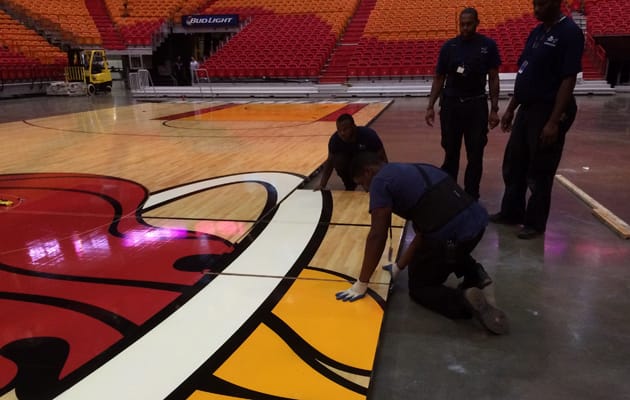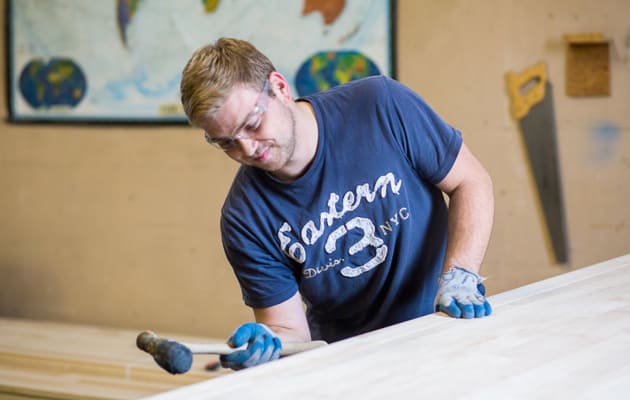What Kind of Wood Is a Basketball Court Made From
Tromp through the forests of the Upper Midwest—think Wisconsin and Michigan, specifically—and you'll run across plenty of acer saccharum or hard maple, the kind that makes up 29 of 30 NBA hardwood courts.
"This is where the greatest density of that particular specie of maple is grown," Doug Hamar, Horner Flooring president, tells SI.com. "It is selected over others because it is harder than other hardwoods, is a tighter grained product, and is light in color."
The NBA leans on three companies for all its flooring needs—Horner, Robbins and Connor Sports Flooring—and they all source their maple from the same region, even if floor similarities stop there.
• MORE NBA: The Fundamentals: Lakers hold Clarkson, Russell back
The tight grain ensures the hardness of maple, giving it the durability needed to withstand NBA seasons and the 70 or so floor conversions an NBA arena goes through each year. The NBA requires teams to replace the floor every 10 years, although one team has received annual waivers, making their floor last 19 years. The lightness of the wood helps provide contrast against the ball, making it easier for players to discern its movement. Plus, the lighter color on the floor reflects light better and helps brighten arenas.
While the maple trees may start out nearly the same, finished floors can differ. The flooring strips are typically comprised just thicker than ¾ of an inch, a dimension, Hamar says, that has been around since maple flooring was first produced in the late 1800s. That thickness turned into a tradition that has carried through even now.

courtesy Robbins
Maple hardwood floor pieces get graded—first, second and third grades—by the Maple Flooring Manufacturing Association. Sometimes those differing grades help to create the specific look of an NBA floor.
"If a team wants their floor to be lighter in color, we will manufacture out of first grade and there are things in the finishing process to enhance that lightness of color as well as preserve it," Hamar says. "If there are areas where they want a multi-grade look, you could do first grade in the center and third grade around the perimeter for a picture frame type of look."
Not only can the differing woods provide looks around the court, but other floors, such as the parquet pattern in Orlando and Boston or the herringbone in Brooklyn, create a pattern on the 94-by-50 playing surface by placing differing grades of wood. Of course, Boston has always bucked tradition with its red oak floor.
SI Recommends
Below the hardwood comes plenty of company-specific creation as well, with subflooring systems consisting of everything from plywood construction to specialized cushioning systems.
First-time NBA All-Star candidates: Running down potential nominees
Greg Pierce, portables manager for Robbins, tells SI.com that all of his company's NBA floors use a "resilient package" that includes a cushion pad. "Adding the resilient package helps with shock absorption, ball bounce and vibration control, which leads to better athletic performance," he says.
Hamar says Horner NBA floors come with a mix of their proprietary cushioning systems and without. "The cushions or pads on the underside of the floor to enhance resiliency characteristics are sometimes opted for, but not all the time," he says. Depending on the amount of cushion, the NBA floors absorb energy. Too much absorption means that players don't get as much energy returned to them, and the less energy returned the harder it is to run, like running on sand or in water. "You don't want the floor surface to absorb too much of the athlete's energy," Hamar says. "Some athletes prefer a harder surface for playing their games so they get more energy return."

courtesy Robbins
As the aesthetics of NBA floors have morphed—two teams, Golden State and Milwaukee, even have alternate floors for this season—so has the process of designing. To get the mountain scene Horner places on the Denver floor or the cityscape Robbins offers Cleveland, for example, the manufacturing process includes staining the maple. Minnesota has one of the darkest stains in the league, while Charlotte has employed a honeycomb pattern and New Orleans offers a pelican silhouette. No matter the design, Hamar says, companies must always ensure that whether bare, stained or painted, the floor takes the final finish coat—a high-gloss polyurethane used for the most available grip—exactly the same.
Below that oil- or water-based final finish, which is reapplied every off-season, as per NBA rules, also comes plenty of paint, with center-court logos averaging 300 square feet in the NBA and city names or nicknames adorning the baselines, along with arena names, the NBA logo and secondary logos.
"We have to be 100 percent confident that the finish is going to perform the same at all points on the floor," Hamar says. "We don't want (players) to fear losing traction."
Even with the diversity in sub-floor systems, stain, paint and final finishes, there's one near constant (with apologies to Boston) in the NBA: all that maple hardwood.
Tim Newcomb covers stadiums, sneakers and technology for Sports Illustrated. Follow him on Twitter at @tdnewcomb.
What Kind of Wood Is a Basketball Court Made From
Source: https://www.si.com/nba/2015/12/02/nba-hardwood-floors-basketball-court-celtics-nets-magic-nuggets-hornets
0 Response to "What Kind of Wood Is a Basketball Court Made From"
Post a Comment